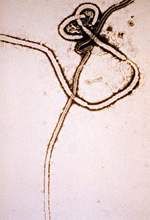Viral traits may predict host-jumping
January - February, 2009 | Volume 8, Issue 1

Photo courtesy of CDC
Electron micrograph of the
ebola virusEarly detection of the next SARS or Ebola-like threat may be aided by a molecular trait identified by a Fogarty researcher that can be used to help evaluate the risk that an animal virus will be able to infect humans.
Dr. Juliet Pulliam, working in the Research and Policy in Infectious Disease Dynamics team, and coauthor Dr. Jonathan Dushoff of Princeton University, did the first quantitative analysis of the predictability of viral transmission between host species. It is the first study to ask how specific molecular characteristics may pre-adapt a virus for emergence by addressing the pool from which these pathogens are drawn.
“We … find that the ability to complete replication within the cytoplasm (i.e., without nuclear entry) is a strong predictor of zoonotic transmission ability,” they said in the Feb. 15 issue of the Journal of Infectious Diseases.
Two other traits—having an RNA genome and having a segmented genome—were not significantly correlated with the ability of livestock viruses to infect humans, they said.
Pulliam, JRC and J Dushoff. (2009) Ability to replicate in the cytoplasm predicts zoonotic transmission of livestock viruses. The Journal of Infectious Diseases 2009;199:565–568.
To view Adobe PDF files,
download current, free accessible plug-ins from Adobe's website.